Air travel has seen a surge in demand over the years, and airlines have responded with innovative strategies to enhance passenger comfort. One such strategy is the introduction of the ‘Premium Economy’ class – a step up from the traditional economy class, but not as opulent as business class. But what exactly sets premium economy apart from its standard counterpart? Let’s explore the five main differences between economy and premium economy.
Table of Contents
The 5 Main Differences Between Economy and Premium Economy
1. Seat Comfort and Space
Perhaps the most significant and immediately noticeable difference between economy and premium economy lies in the seat comfort and the space provided.
In economy class, the seats are more compact, designed to accommodate as many passengers as possible. The seat pitch, which is the distance between your seat and the one in front of you, typically ranges from 29 to 32 inches. While the seats are designed to provide adequate comfort for short to medium-haul flights, they might seem cramped for long-haul journeys.
On the other hand, premium economy seats are more spacious, with a wider seat width and a pitch ranging from 38 to 42 inches, which allows for more legroom. The seats are often wider, too, and may feature an adjustable headrest, leg rest, or even a footrest.
2. Dining Options
The onboard dining experience also differentiates the two classes.
In economy class, meals are relatively simple but cover the necessary bases – usually a choice between chicken, beef, or vegetarian options. In addition, economy passengers typically receive complimentary soft drinks and must pay for alcoholic beverages.
Premium economy ups the ante with a menu that more closely resembles what you might expect in business class. The meals are often of higher quality, and passengers can expect a greater selection of complimentary alcoholic beverages. Some airlines even provide premium economy passengers with welcome drinks upon boarding and offer the use of real china and glassware.
3. Entertainment and Amenities
When it comes to in-flight entertainment and amenities, premium economy wins again.
While economy class does provide in-flight entertainment systems, the screen size tends to be smaller, and the complimentary earphones provided are basic. Amenities usually include a blanket and a pillow, with other items like amenity kits and headphones available for purchase.
In contrast, premium economy offers larger, high-resolution screens and provides higher quality noise-cancelling headphones. Many airlines also offer enhanced amenity kits, with items such as eye masks, earplugs, socks, toothbrushes, and premium skincare products.
4. Baggage Allowance and Check-in
Most airlines are more generous with their baggage allowances for premium economy passengers. This could mean being allowed to check an extra bag, or being granted a higher weight limit for your luggage.
In addition, premium economy passengers often benefit from priority check-in and boarding, which allows them to avoid long lines and provides a smoother, more enjoyable travel experience.
5. Price Point
Of course, all these additional perks and comforts of premium economy come with a higher price tag compared to economy class. The price difference can range anywhere from 20% to 80% more than a standard economy ticket, depending on the airline and the specific route.
So, is premium economy worth the extra cost? It depends on individual preferences and priorities. For some, the extra comfort, larger seats, better food and drink options, and additional amenities make the extra expense worthwhile, especially on long-haul flights. However, for budget-conscious travelers or those on shorter flights, economy class might serve their needs just as well.
Which is better: premium economy or economy?
There is no definitive answer to this as it largely depends on personal preferences, the length of the flight, and your budget. If comfort is a priority and you don’t mind paying extra, premium economy may be the best choice for you. The extra legroom and wider seats can make a significant difference, particularly on long-haul flights.
However, if you are on a budget or don’t mind sacrificing some comfort for savings, economy class may be more suitable. After all, all passengers reach the same destination regardless of their class of service. What matters most is your comfort and how much you’re willing to spend on it.
Are premium economy seats worth it?
In determining the value of premium economy, consider the length of your flight and your personal comfort needs. On short flights, the difference between economy and premium economy may not justify the extra cost. But for long-haul flights, the larger seat, better meal service, enhanced entertainment system, and extra luggage allowance may provide enough value to make the higher price worthwhile.
Remember, you’re not just paying for more space; you’re paying for a better overall experience. If that’s important to you and you don’t mind the higher price, then premium economy can certainly be worth it.
Conclusion: Navigating the Friendly Skies
Navigating the world of air travel can be confusing with so many options available. By understanding the key differences between economy and premium economy, you can make an informed decision based on your budget, comfort needs, and flight duration.
Keep in mind that the specifics of what each airline offers in their economy and premium economy classes can vary, so it’s always best to check the airline’s website or contact them directly for the most accurate information. Whether you decide to fly economy or premium economy, remember that the journey is just as important as the destination. Happy travels!
Links to the Premium Economy Pages for some of the top airlines:


